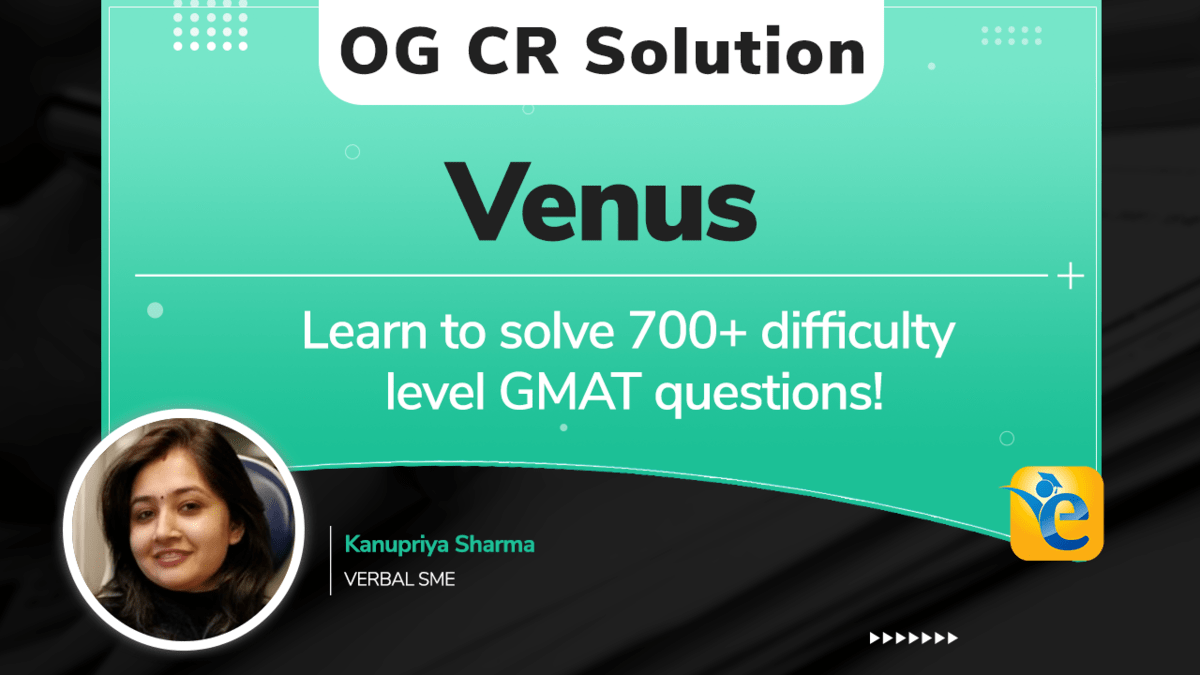In this article, we’ll look at the solution to this Official Guide (OG) question CR06831 – “Curator: If our museum lends Venus to the Hart Institute…” on critical reasoning.
Curator: If our museum lends Venus to the Hart Institute for their show this spring, they will lend us their Rembrandt etchings for our print exhibition next fall. Having those etchings will increase attendance to the exhibition and hence increase revenue from our general admission fee.
Museum Administrator: But Venus is our biggest attraction. Moreover the Hart’s show will run for twice as long as our exhibition. So on balance the number of patrons may decrease.
The point of the administrator’s response to the curator is to question?
[Refer to GMAT Official Guide for options]
Here is some general information about this official guide question:
- PQID: CR06831 (OG Verbal Review)
- Difficulty Level: Medium
- Most Common Incorrect option choice: Choice D
- Question Type: Structure
OG Video Solution – CR06831 – Curator: If our museum lends Venus to the Hart Institute…
OG Solution – CR06831 – Curator: If our museum lends Venus to the Hart Institute…
Hi Student, here I am with another conversation-based question in which you need to understand the role one person’s argument plays with respect to the argument of another person. If you find such questions difficult, this article can be a good starting point for you. In case you are slightly confident about these questions, this article will help you cement your understanding. So, please don’t skip it.
How to Solve Such Questions?
As discussed, this question asks you to define the role played by an argument of a person in response to the argument given by another person. You will be glad to know that you do not need any new skills to answer such questions correctly. In fact, these questions can be solved in fewer steps. All you need to do is understand the argument and decide the roles played by each argument. I would say that these questions are very similar to boldface questions, just that they are written in a different way, and they may have multiple conclusions. Let’s understand the steps that you need to follow to solve such questions.
Steps For Solving Such Questions

- Understand and visualize the argument- As with every CR question, understanding and visualizing the argument is the key to easily solving such questions. So, don’t hesitate to spend some time understanding the argument.
- Understand the question stem- The question stem of such questions is very important since it defines the direction of analysis. In other questions, you analyze everything with respect to the main conclusion. So, the main conclusion is the basis of your analysis of those questions. The same basis here is defined in the question stem since the arguments in these questions do not have any single main conclusion.
- Analyze the role played by the argument of each person – This is the pre-thinking step in which you decide what the correct answer choice should convey. The correct answer choice may use different words but will convey the same meaning.
- Answer choice analysis- The easiest of all steps because now you just need to understand every choice and check if it conveys the same meaning as your pre-thought answer. So, reject the incorrect answer choices and mark the correct one confidently!
I am sure you have noticed that these steps are not very different from our usual process for solving other questions. In fact, the pre-thinking step is similar since you need not think about any new information- you just have to describe what is given to you. Hence, if you can solve other questions, you can solve these questions too.
Let’s apply these steps to this question now.
Step 1- Argument Analysis
![Curator If our museum lends Venus to the Hart Institute... [OG solutions]](https://cdn.e-gmat.com/blogs/wp-content/uploads/2021/12/gmat-og-solution-curator-if-our-museum-lends-venus-to-the-hart-institute-1024x576.png)
This question is about a conversation between person 1- the Curator and person 2- the Museum Administrator.
Viewpoint of the Curator-
The curator talks about the benefit of lending Venus to another institute – the Hart Institute- (HI) for one of their shows. So, we know that Venus is a work that belongs to the museum in which the curator works. In return, HI will lend them one of their works, the Rembrandt etchings (RE), for their print exhibition next fall. If the museum has RE, it will attract more people to attend the print exhibition, and this will help increase the revenue from the entrance fee.
Response by the Museum Administrator–
The use of “but” to start the response conveys that the administrator is not completely aligned with the curator, and he will present a piece of information that will go against the curator’s suggestion.
The first reason given by the administrator to dismiss the curator’s argument is that Venus is the main attraction of the museum. Most likely, the administrator is trying to convey that Venus attracts a lot of their patrons, and if they lend Venus to HI, then many people who would have otherwise visited the museum to see Venus will now visit HI’s show. This will reduce the number of people visiting the museum- an outcome that is opposite to that suggested by the curator.
The second reason given by the administrator is that the duration of HI’s show is double that of the museum’s show. Considering this reason, we can say that the museum may actually lose more than it gains in this deal. Let’s understand it with an example:
Let’s say
- Venus on its own attracts 50 people every week
- RE on its own attracts 50 people every week.
- HI’s show runs for two weeks.
- The museum’s show runs for one week.
- Gain for the museum- 50 extra customers for one week.
- Loss for the museum- 50 fewer customers for two weeks, i.e., 100 customers
Based on these two reasons, the administrator suggests that this plan may actually reduce the number of patrons for the museum.
Step 2 – Question Stem Analysis
The question stem asks us to find the answer choice that describes what the administrator wants to challenge in the curator’s argument. So, the viewpoint of the curator is the basis, and we need to describe the role of the administrator’s response.
Step 3- Prethink
![Curator If our museum lends Venus to the Hart Institute... [OG solutions]](https://cdn.e-gmat.com/blogs/wp-content/uploads/2021/12/gmat-og-solution-curator-if-our-museum-lends-venus-to-the-hart-institute-2-1024x576.png)
We have seen that the administrator provides two reasons to convey that the plan to lend Venus to HI may actually decrease the overall attendance and hence the revenue of the museum instead of increasing it. Thus, the point of his argument is to question whether the plan can give the desired output, i.e., whether the plan can help increase the overall attendance of the museum.
The correct answer choice should convey the same meaning.
Step 4- Answer Choice Analysis
Choice A
The administrator does not disagree in terms of the impact of getting RE. What he is interested in knowing is the impact of lending Venus, along with getting RE. Hence, this choice is incorrect.
Choice B
This choice talks about a group of patrons for whom the museum’s biggest attraction is Venus. Now, whether RE will be appreciated by this group of patrons or not is irrelevant as long as RE can attract new patrons who would not have come to the museum otherwise. As discussed in choice A, the administrator does not disagree on the impact of getting RE to the museum, i.e., he does not question whether RE will not be able to attract new patrons Hence, this choice is incorrect.
Choice C
This choice compares the number of additional patrons attracted by RE to the museum and the number of patrons lost by the museum because of lending Venus. Hence, in other words, this choice compares the number of additional patrons the museum will get as a result of this deal with the number of patrons it will lose. Thus, this choice is in line with our prethinking and is the correct choice.
Choice D
If you selected this choice, then you failed in step 4- answer choice analysis. Let’s see what this choice means.
This choice talks about the scenario in which Venus has been lent to HI and compares the museum’s revenue during HI’s exhibition with that during the print exhibition. But is this comparison correct? No.
The administrator is not concerned about which show will be more profitable to the museum. He is concerned about the impact of lending Venus on the overall revenue of the museum. Thus, he intends to compare the overall revenue of the museum in case Venus is lent with the overall revenue in the case Venus is not lent.
Hence, even though attractive, this choice is incorrect.
Choice E
The administrator is not concerned with the profit being made by HI with this deal. He is only concerned about the overall impact on the revenue of the museum. Hence, this choice is incorrect.
Takeaways – Curator: If our museum lends Venus to the Hart Institute…
![Curator If our museum lends Venus to the Hart Institute... [OG solutions]](https://cdn.e-gmat.com/blogs/wp-content/uploads/2021/12/gmat-og-solution-curator-1024x576.png)
- Conversation-based questions that ask for the role played by a person’s argument can be easily solved by understanding the conversation properly. This step is a key step in this process.
- It is very important to analyze the question stem of such questions since it describes what we are expected to do in that question.
- Prethinking helps us understand what the correct answer choice should convey and makes answer choice analysis easy.
- Always understand the exact meaning of each choice before selecting/ rejecting it. Trap answer choices, such as choice D here, use terms that make the choice attractive if not analyzed properly.
Practice OG questions
You can now try solving these similar questions to cement your understanding. Solve them again using the process discussed, even if you are already familiar with them.
OG Question 1 – Sasha: It must be healthy to follow a diet…
Sasha: It must be healthy to follow a diet high in animal proteins and fats. Human beings undoubtedly evolved to thrive on such a diet, since our prehistoric ancestors ate large amounts of meat.
Jamal: But our ancestors also exerted themselves intensely in order to obtain this food, whereas most human beings today are much less physically active.
Jamal responds to Sasha by doing which of the following?
OG Question 2 – City resident: These new digital electronic billboards should…
Try this question to cement your understanding of the structure of an argument.
City resident: These new digital electronic billboards should be banned for light pollution since they are much too bright.
Outdoor advertising spokesperson: No, that’s not true. Testing with a sophisticated light meter shows that at night they throw off less light than traditional billboards that are reflectively lit. Your mistaken perception that they are brighter comes from looking directly at the light source—the screen itself.
The underlying strategy of the spokesperson’s response to the resident is most analogous to the underlying strategy of which of the following?
Happy learning!
Kanupriya
Planning to take the GMAT? We can give you access to quality online content to prepare. We are the most reviewed GMAT prep company on the GMAT club with more than 2200+ reviews and have delivered 10x 700+ scores than the average GMATClub partner. Why don’t you take a free trial and judge it for yourself? Write to us at acethegmat@e-gmat.com in case of any queries.















